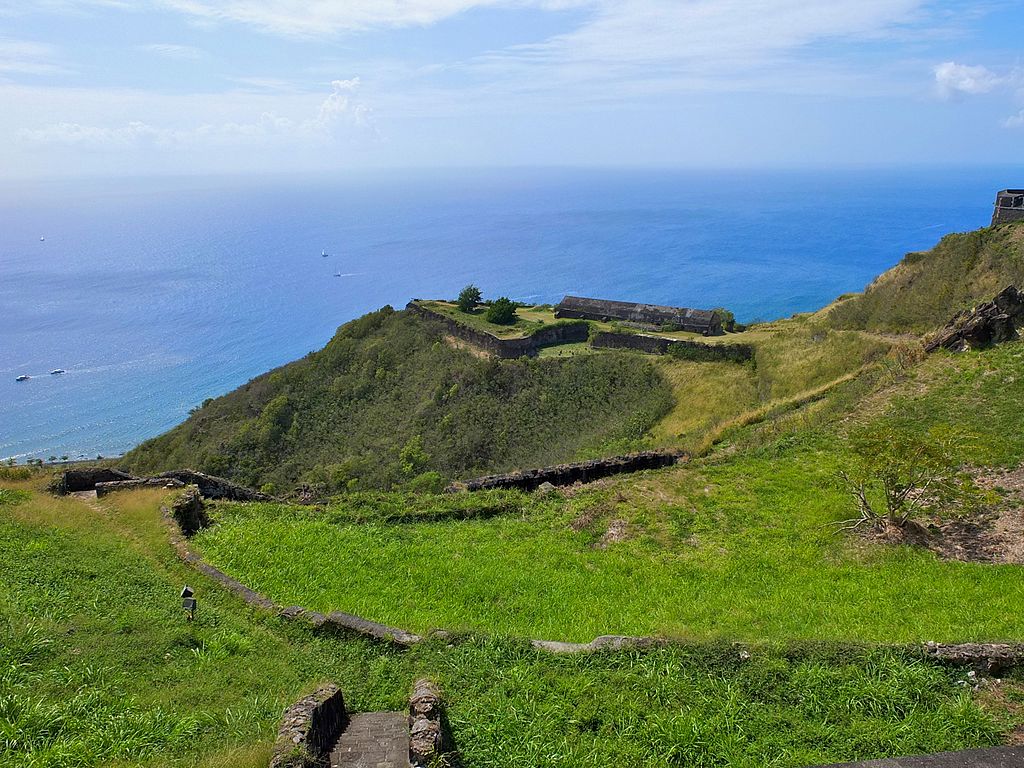The island nation of Saint Kitts & Nevis in the West Indies is one of our homeschool countries-of-the-week, so why not spend a few minutes today learning about one of Saint Kitts’ World Heritage Sites: Brimstone Hill Fortress National Park.

The island of Saint Kitts, also known as Saint Christopher, is one of the two principal islands that make up the West Indian nation of Saint Kitts & Nevis. As with many other West Indian islands, control of Saint Kitts was long contested between the French and British. Brimstone Hill was a British fortress built to guard the island from French incursions.
Brimstone Hill Fortress National Park is a remarkable example of European military engineering dating from the 17th and 18th centuries in a Caribbean context. Located on the Island of St. Christopher (St. Kitts), the country’s largest island, the fortress was built by African slave labour to the exacting standards of the British military to protect the coastline from a sea attack and to provide a safe refuge for the island’s citizens. The engineers who designed the fort made use of the natural topography of this double-peaked steep volcanic hill rising 230 meters.
St. Christopher (St. Kitts), as the first West Indian Island to be colonized by Europeans, specifically the French and English, was the scene of many battles in the struggle for dominance in this region. The earliest use of Brimstone Hill for European military purposes was in 1690 when the British installed a cannon to drive out the French. The fortress evolved over the next century and served until 1853 when the British military abandoned it and dismantled many of the buildings.
The principal structures of the fortress are situated on different levels of the upper third of the hill and were constructed in dressed stone (basalt) blocks with a rubble core. Local limestone was used as a decorative element for quoins and for facing around doorways and embrasures. Quarries on the middle and lower slopes of the hill provided much of the stone. The heart of the fortress, Fort George, also known as the Citadel, dominates one of the twin peaks. Completed towards the end of the 1700s, this is the earliest surviving example of the “Polygonal System” of fortress design. (World Heritage Centre #910)
You can find a gallery of additional photos of Brimstone Hill Fortress National Park on the World Heritage Centre’s website.

World Heritage Sites are cultural or natural landmarks of international significance, selected by their home countries and recognized by the United Nations Educational, Scientific, and Cultural Organization. More than a thousand such sites have been designated in over 160 countries, and we feature one every Wednesday, drawn from one of our homeschool countries-of-the-week. You can find a complete list of World Heritage Sites online at the World Heritage Centre and in Wikipedia.
The World Heritage Centre also has a free and comprehensive World Heritage education kit for teachers, as well as a wonderful full-color wall map of World Heritage Sites, available for the cost of shipping. Why not add them both to your own homeschool library. 🗺
What world treasures have you explored in your homeschool this Leo Term? 😊
❡ The great globe itself: This is one of our regular Homeschool Geography posts featuring cultural and natural sites of international importance. Print your own copy of our River Houses World Heritage Calendar and follow along with us as we tour the planet, and add your name to our weekly mailing list to get great homeschool teaching ideas delivered right to your mailbox all through the year. 🌐
❡ Print this little lesson: Down at the bottom of this post you'll find a special "Print" button that will let you create a neat and easy-to-read copy of this little lesson, and it will even let you edit and delete sections you don't want or need (such as individual images or footnotes). Give it a try today! 🖨
❡ Books in the running brooks: You can always turn to your River Houses almanac, atlas, and history encyclopedia for more information about any of our countries-of-the-week. The almanac has a lengthy section with detailed profiles of all the nations of the world; the endpapers of the atlas are indexes that will show you where all of the individual national and regional maps may be found; the history encyclopedia has a comprehensive collection of national histories in an appendix; and you can find additional illustrations, flags, and other mentions through the indexes in each of these volumes. For an ideal little lesson, just write the name of the Weekly World Heritage Site on your homeschool bulletin board, find its location in your atlas, read the WHC's brief description aloud, look at a picture or two, and you're done. Over the course of the year, without even realizing it, your students will absorb a wealth of new historical, geographical, and cultural information. 📚
❡ Homeschool calendars: We have a whole collection of free, printable, educational homeschool calendars and planners available on our main River Houses calendar page. They will help you create a light and easy structure for your homeschool year. Give them a try today! 🗓
❡ Support our work: If you enjoy our educational materials, please support us by starting your regular Amazon shopping from our very own homeschool teaching supplies page. When you click through from our page, any purchase you make earns us a small commission at no extra cost to you. Thank you for helping us to keep going and growing! 🛒
❡ Join us! The aim of the River Houses project is to create a network of friendly local homeschool support groups — local chapters that we call “Houses.” Our first at-large chapter, Headwaters House, is now forming and is open to homeschoolers everywhere. Find out how to become one of our founding members on the Headwaters House membership page. 🏡




